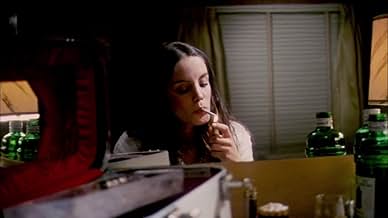Agrega una trama en tu idiomaA beautiful stripper hires renowned criminals to exact revenge on those who raped her in her motel room.A beautiful stripper hires renowned criminals to exact revenge on those who raped her in her motel room.A beautiful stripper hires renowned criminals to exact revenge on those who raped her in her motel room.
- Dirección
- Guionistas
- Elenco
- Dirección
- Guionistas
- Todo el elenco y el equipo
- Producción, taquilla y más en IMDbPro
Opiniones destacadas
Denys Arcand's "Gina" (1975) is a film that defies easy categorization. It's a vengeance thriller fueled by a brutal assault, set against the backdrop of a bleak Canadian winter and interwoven with a social commentary on labor exploitation. While undeniably compelling, "Gina" stumbles with uneven pacing and a tonal shift that may leave some viewers wanting more.
The film centers around Gina, a captivating yet vulnerable stripper (Céline Lomez), forced to perform at a seedy motel. Her arrival coincides with a documentary crew exploring the harsh realities of a local textile mill. Interweaving documentary and fictional elements, Arcand paints a picture of a community struggling with economic hardship. This social commentary adds depth, but can feel disjointed at times.
The narrative takes a sharp turn when Gina is attacked by a group of snowmobile-riding thugs. This brutal scene is unflinching and sets the stage for Gina's chilling quest for revenge. Arcand masterfully utilizes the desolate winter landscape, creating a sense of isolation that amplifies the film's emotional impact. However, the pacing can feel slow, particularly in the first act, as the film establishes its characters and setting.
The true strength of "Gina" lies in its exploration of female agency. Here's a woman wronged, who refuses to be a victim. She seeks out a notorious Montreal gang to enact her revenge, a decision fraught with danger and moral ambiguity. Lomez delivers a powerful performance, capturing Gina's vulnerability, resilience, and steely resolve.
The final act explodes with a brutal and bloody showdown, complete with a show-stopping snowmobile chase. This visceral sequence is undeniably thrilling, but feels somewhat tonally incongruous with the film's more measured social commentary.
"Gina" is a fascinating and flawed film. It's a must-see for fans of Canadian cinema and those interested in a unique take on the revenge genre. However, viewers seeking a consistently paced and tightly focused narrative may find themselves wanting.
The film centers around Gina, a captivating yet vulnerable stripper (Céline Lomez), forced to perform at a seedy motel. Her arrival coincides with a documentary crew exploring the harsh realities of a local textile mill. Interweaving documentary and fictional elements, Arcand paints a picture of a community struggling with economic hardship. This social commentary adds depth, but can feel disjointed at times.
The narrative takes a sharp turn when Gina is attacked by a group of snowmobile-riding thugs. This brutal scene is unflinching and sets the stage for Gina's chilling quest for revenge. Arcand masterfully utilizes the desolate winter landscape, creating a sense of isolation that amplifies the film's emotional impact. However, the pacing can feel slow, particularly in the first act, as the film establishes its characters and setting.
The true strength of "Gina" lies in its exploration of female agency. Here's a woman wronged, who refuses to be a victim. She seeks out a notorious Montreal gang to enact her revenge, a decision fraught with danger and moral ambiguity. Lomez delivers a powerful performance, capturing Gina's vulnerability, resilience, and steely resolve.
The final act explodes with a brutal and bloody showdown, complete with a show-stopping snowmobile chase. This visceral sequence is undeniably thrilling, but feels somewhat tonally incongruous with the film's more measured social commentary.
"Gina" is a fascinating and flawed film. It's a must-see for fans of Canadian cinema and those interested in a unique take on the revenge genre. However, viewers seeking a consistently paced and tightly focused narrative may find themselves wanting.
After long and careful consideration, I don't see any other option than to categorize this film in the league of "interesting failures", otherwise known as the "Yes but No" category. "Gina" is a curiously compelling and unique film, but I can't possibly describe it as good or recommendable. This movie serves the weirdest combo of topics that I have ever seen; seriously. It's a harsh social drama, criticizing the harsh labor conditions and low wages of people working in contemporary textile factories in Canada, but simultaneously it also builds up towards a typically mid-70s Rape & Revenge exploitation thriller.
Gina, a strong and independent exotic dancer moves to a remote Vancouver community where everybody works in the nearby textile plant. In the bar/motel where she works and lives, Gina befriends a film crew that is shooting a documentary on the unfair working conditions at the factory, but she also gets frequently confronted with drunk, depressed, and aggressive local males.
There's an uncannily captivating atmosphere in "Gina" that keeps you glued to the screen, but there honestly isn't happening anything at all throughout the first complete hour. To illustrate this: the film features how four people play a game of pool from start to finish, or endlessly drive around on snow scooters. Only the climax becomes reasonably eventful, with a stoic gang rape and a brutal retribution aboard an abandoned ship.
(*) User-comment title inspired by the lyrics of Falco's "Jeanny"
Gina, a strong and independent exotic dancer moves to a remote Vancouver community where everybody works in the nearby textile plant. In the bar/motel where she works and lives, Gina befriends a film crew that is shooting a documentary on the unfair working conditions at the factory, but she also gets frequently confronted with drunk, depressed, and aggressive local males.
There's an uncannily captivating atmosphere in "Gina" that keeps you glued to the screen, but there honestly isn't happening anything at all throughout the first complete hour. To illustrate this: the film features how four people play a game of pool from start to finish, or endlessly drive around on snow scooters. Only the climax becomes reasonably eventful, with a stoic gang rape and a brutal retribution aboard an abandoned ship.
(*) User-comment title inspired by the lyrics of Falco's "Jeanny"
"Gina," a Canadian film from 1975, is a curious beast. On the surface, it ticks all the boxes of a typical rape-revenge exploitation film of its era. However, beneath the surface, it offers a unique and compelling narrative that explores broader ideas and themes.
The story follows the title character, Gina, a stripper who is sent to perform at a rural bar in the middle of winter. When she is brutally attacked, she embarks on a violent mission of revenge with the help of her pimp and their henchmen.
What sets "Gina" apart from its contemporaries is director and co-writer Denys Arcand's approach to the material. Arcand, known for his thought-provoking films like "The Barbarian Invasions," uses the exploitative elements as a hook to delve into deeper territory. The sex and violence are undeniably attention-grabbing, but they serve a greater purpose in this film.
"Gina" is an intriguing blend of arthouse and grindhouse. It's a film that challenges its audience, offering a unique take on the revenge narrative. The grit and grime of the setting and the brutal nature of the story are juxtaposed with a thoughtful exploration of human nature and the consequences of violence.
However, despite its ambitious approach, "Gina" falls short of being a truly remarkable film. While it has its moments of brilliance, the overall execution feels uneven. The pacing is often sluggish, and the tone veers wildly from one scene to the next. It is a film that keeps you engaged, but more in the sense of curiosity about where it will go next rather than genuine investment in the characters or their journeys.
That being said, "Gina" is worth watching for those interested in the evolution of exploitation cinema and its intersections with arthouse storytelling. The film's supplementary features, including interviews with Arcand and cast members, as well as a video essay by rape-revenge film scholar Alexandra Heller-Nicholar, provide valuable context and insights into the film's creation and impact.
In conclusion, "Gina" is a fascinating experiment in genre filmmaking that, while not entirely successful, offers a unique and thought-provoking experience.
The story follows the title character, Gina, a stripper who is sent to perform at a rural bar in the middle of winter. When she is brutally attacked, she embarks on a violent mission of revenge with the help of her pimp and their henchmen.
What sets "Gina" apart from its contemporaries is director and co-writer Denys Arcand's approach to the material. Arcand, known for his thought-provoking films like "The Barbarian Invasions," uses the exploitative elements as a hook to delve into deeper territory. The sex and violence are undeniably attention-grabbing, but they serve a greater purpose in this film.
"Gina" is an intriguing blend of arthouse and grindhouse. It's a film that challenges its audience, offering a unique take on the revenge narrative. The grit and grime of the setting and the brutal nature of the story are juxtaposed with a thoughtful exploration of human nature and the consequences of violence.
However, despite its ambitious approach, "Gina" falls short of being a truly remarkable film. While it has its moments of brilliance, the overall execution feels uneven. The pacing is often sluggish, and the tone veers wildly from one scene to the next. It is a film that keeps you engaged, but more in the sense of curiosity about where it will go next rather than genuine investment in the characters or their journeys.
That being said, "Gina" is worth watching for those interested in the evolution of exploitation cinema and its intersections with arthouse storytelling. The film's supplementary features, including interviews with Arcand and cast members, as well as a video essay by rape-revenge film scholar Alexandra Heller-Nicholar, provide valuable context and insights into the film's creation and impact.
In conclusion, "Gina" is a fascinating experiment in genre filmmaking that, while not entirely successful, offers a unique and thought-provoking experience.
What I like about this movie? First, the director goes to great length to make us care for the characters. Character development is excellent. The setting is good too. A small town in Québec, ruled by snowmobiles and beer drinking locals at the tavern. I like the documentary style used by Denys Arcand. Great way to show the exploitation of the people working in the textile industry. And great way to show the exploitation of the people, period. As the movie progress, we see that exploitation can take different forms. Gina is not too different from Dolorès, or from the four guys making a film, or from the hotel owner's wife for that matter. I also like the setting just before the gang-rape scene. When Gina is in her room and we hear the snowmobiles arriving. You can just feel the tension.
What I didn't liked about the movie? As for other Québec films, some scenes takes forever. I mean, do we really have to see an entire game of pool? Denys Arcand could have probably do this movie in 80-85 minutes, without missing anything.
Out of 100, I give it 84. That's good for *** out of ****. Seen at home, in Toronto, on December 17th, 2002.
What I didn't liked about the movie? As for other Québec films, some scenes takes forever. I mean, do we really have to see an entire game of pool? Denys Arcand could have probably do this movie in 80-85 minutes, without missing anything.
Out of 100, I give it 84. That's good for *** out of ****. Seen at home, in Toronto, on December 17th, 2002.
"Gina" (1975) is an uneven combination of social docudrama about the working classes of Quebec and a rape-and-revenge story. For most of its running time it doesn't seem to be going anywhere, but a slam-bang action (and gore) climax redeems it somewhat. Celine Lomez's beauty and the snowy landscapes are further assets (the single greatest visual of the film may be a large, abandoned ship on a frozen river), but on the whole "Gina" is a film mostly of interest to director Denys Arcand followers: he didn't hit the big time until 11 years later, with "The Decline Of The American Empire". **1/2 out of 4.
¿Sabías que…?
- ConexionesReferences Las pícaras doncellas (1959)
Selecciones populares
Inicia sesión para calificar y agrega a la lista de videos para obtener recomendaciones personalizadas
- How long is Gina?Con tecnología de Alexa
Detalles
Taquilla
- Presupuesto
- CAD 360,000 (estimado)
- Tiempo de ejecución1 hora 35 minutos
- Color
- Relación de aspecto
- 1.85 : 1
Contribuir a esta página
Sugiere una edición o agrega el contenido que falta

Principales brechas de datos
By what name was Gina (1975) officially released in India in English?
Responda





























